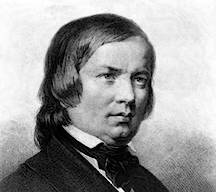|
 Schumann,
Robert Alexander (1810-1856), German composer, a principal figure
of the early romantic movement in 19th-century music. Schumann was
born on June 8, 1810, in Zwickau, Saxony (Sachsen), and educated at
the universities of Leipzig and Heidelberg. The son of a bookseller,
he early became absorbed in literature, particularly that of romanticism.
In 1830 he abandoned the study of law in order to devote himself to
music. He studied piano with the German teacher Friedrich Wieck, but
a permanent injury to one of his fingers forced him to abandon the
career of pianist. He then turned to composition and the writing of
musical essays. In 1834, he founded the music journal Neue Zeitschrift
f�r Musik, which he edited until 1844. Schumann married the pianist
Clara Josephine Wieck, the daughter of his former teacher, in 1840.
In 1843 Schumann was appointed to the faculty of the newly founded
Leipzig Conservatory, but finding himself emotionally unfit for teaching,
he soon resigned. In 1850 he was named town music director at D�sseldorf;
advancing mental illness, which had threatened him since adolescence,
forced him to resign in 1854. That same year Schumann attempted suicide
and was confined to an asylum near Bonn, where he died on July 29,
1856. One of the most typical of romantic composers, Schumann characterized
himself in two imaginary figures, the forceful Florestan and the poetic
Eusebius, whose names he signed to his critical articles and whose
musical portraits he drew in his piano suite Carnaval (1834-1835).
During 1840, he achieved what generally is considered his greatest
work when he suddenly turned to the song form. In that year he composed
138 songs of the finest quality, among them the great song cycles
Liederkreis (two cycles, texts by Heinrich Heine), Myrthen (texts
by various poets), Frauenliebe und Leben (Woman's Love and Life, text
by Adelbert von Chamisso), and Dichterliebe (Poet's Love, text by
Heinrich Heine). Schumann concentrated on the psychological subtleties
of a poem and in his songs gave to the piano accompaniment an equal
role in expressing the mood and meaning of a poem. Schumann's piano
works are largely musical expressions of literary themes and moods.
With the exception of the Fantasy in C Major (1836) and �tudes Symphoniques
(1854), his best piano compositions consist of cycles of short pieces
in which a single lyrical idea is brought to completion within a small
framework. In addition to Carnaval, they include Papillons (Butterflies,
1820-1831), Kinderscenen (Scenes from Childhood, 1838), Kreisleriana
(1838), and Album f�r die Jugend (Album for the Young, 1848). Although
Schumann rarely achieved in his larger works the unity of form found
in his songs and piano pieces, they do contain much that is beautiful
and dramatic. This is particularly true of the First Symphony (1841),
Piano Quintet (1842), Piano Concerto (1845), Second Symphony (1846),
and Piano Trio (1847). Among his other compositions are a choral work,
Das Paradies und die Peri (Paradise and the Peri, 1843), and an unsuccessful
opera, Genoveva (1847-1848). Schumann,
Robert Alexander (1810-1856), German composer, a principal figure
of the early romantic movement in 19th-century music. Schumann was
born on June 8, 1810, in Zwickau, Saxony (Sachsen), and educated at
the universities of Leipzig and Heidelberg. The son of a bookseller,
he early became absorbed in literature, particularly that of romanticism.
In 1830 he abandoned the study of law in order to devote himself to
music. He studied piano with the German teacher Friedrich Wieck, but
a permanent injury to one of his fingers forced him to abandon the
career of pianist. He then turned to composition and the writing of
musical essays. In 1834, he founded the music journal Neue Zeitschrift
f�r Musik, which he edited until 1844. Schumann married the pianist
Clara Josephine Wieck, the daughter of his former teacher, in 1840.
In 1843 Schumann was appointed to the faculty of the newly founded
Leipzig Conservatory, but finding himself emotionally unfit for teaching,
he soon resigned. In 1850 he was named town music director at D�sseldorf;
advancing mental illness, which had threatened him since adolescence,
forced him to resign in 1854. That same year Schumann attempted suicide
and was confined to an asylum near Bonn, where he died on July 29,
1856. One of the most typical of romantic composers, Schumann characterized
himself in two imaginary figures, the forceful Florestan and the poetic
Eusebius, whose names he signed to his critical articles and whose
musical portraits he drew in his piano suite Carnaval (1834-1835).
During 1840, he achieved what generally is considered his greatest
work when he suddenly turned to the song form. In that year he composed
138 songs of the finest quality, among them the great song cycles
Liederkreis (two cycles, texts by Heinrich Heine), Myrthen (texts
by various poets), Frauenliebe und Leben (Woman's Love and Life, text
by Adelbert von Chamisso), and Dichterliebe (Poet's Love, text by
Heinrich Heine). Schumann concentrated on the psychological subtleties
of a poem and in his songs gave to the piano accompaniment an equal
role in expressing the mood and meaning of a poem. Schumann's piano
works are largely musical expressions of literary themes and moods.
With the exception of the Fantasy in C Major (1836) and �tudes Symphoniques
(1854), his best piano compositions consist of cycles of short pieces
in which a single lyrical idea is brought to completion within a small
framework. In addition to Carnaval, they include Papillons (Butterflies,
1820-1831), Kinderscenen (Scenes from Childhood, 1838), Kreisleriana
(1838), and Album f�r die Jugend (Album for the Young, 1848). Although
Schumann rarely achieved in his larger works the unity of form found
in his songs and piano pieces, they do contain much that is beautiful
and dramatic. This is particularly true of the First Symphony (1841),
Piano Quintet (1842), Piano Concerto (1845), Second Symphony (1846),
and Piano Trio (1847). Among his other compositions are a choral work,
Das Paradies und die Peri (Paradise and the Peri, 1843), and an unsuccessful
opera, Genoveva (1847-1848).
|